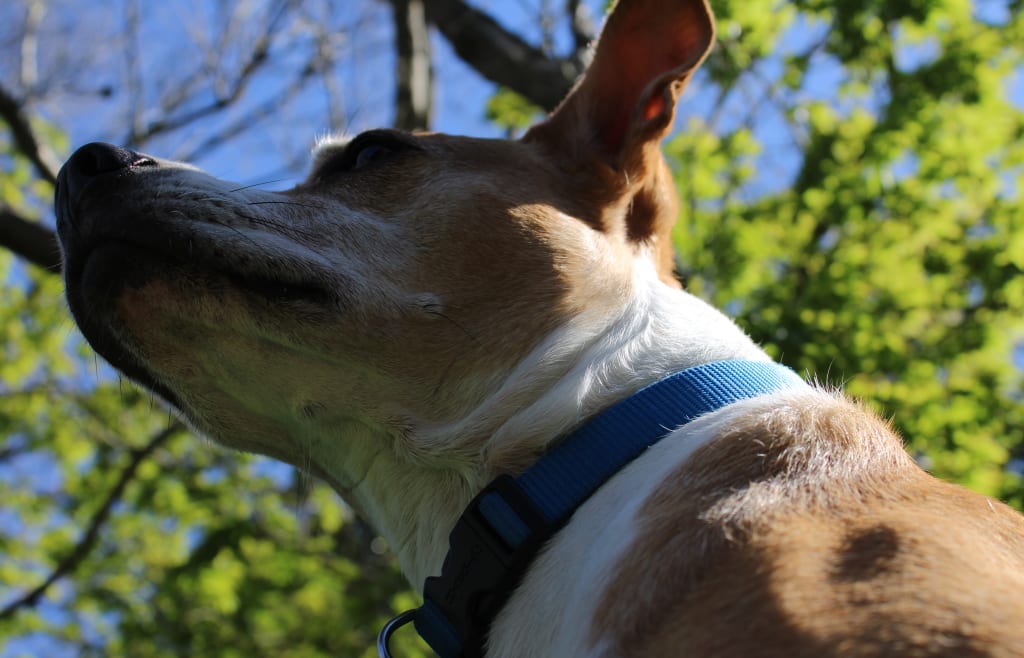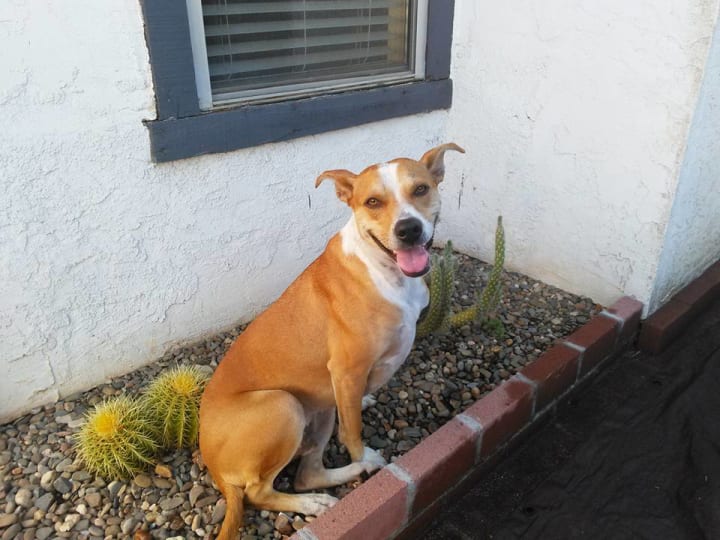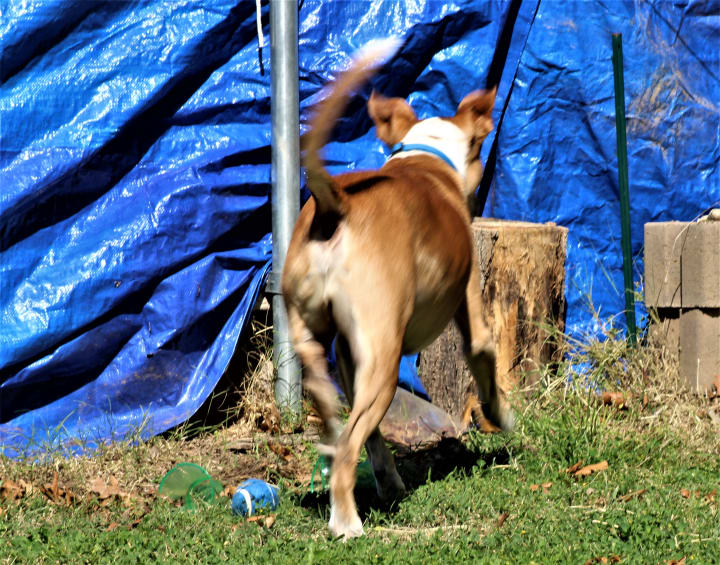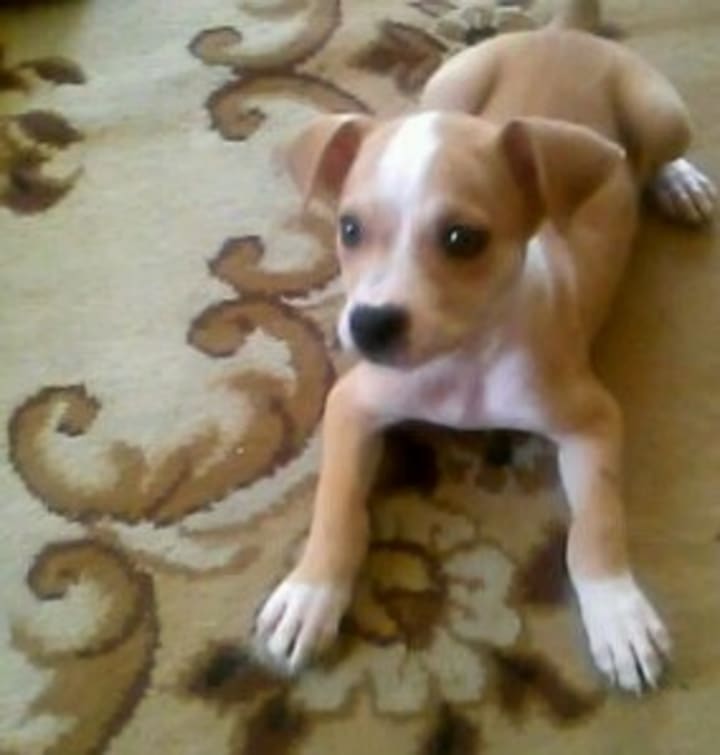
I enjoy helping new dog parents understand what's going on in their dogs head. How to read their emotions and behaviors. How to counteract bad behaviors. My goal is to make sure dogs do not end up at a shelter or on the street, or even worse sent to doggie death row for behavior that could be avoided. My financial goal for my passion is to create a digital dog training course, stylized from a dogs perspective, that can be uploaded to a video streaming site or sold to individuals in an online marketplace.

Meet Mike. He was the ambassador for good dogs during my stint as a professional dog trainer. He was a fixture at my training location and became friends with many trainees. He served as an example to show other good dogs how to live in a happy symbiotic relationship with their parents. He helped them learn new skills, how to interact with other dogs and how to pee outside instead of on their parents rug or laundry basket. After training for a company, I moved on to private training sessions and really hit my stride. Mike is an excellent showman and made it easy to train on my own.
Today, Mike is going to tell you how to be a good dog parent and why it is important to learn these life skills. He knows that many pups end up in shelters or on the street because they didn't fit in well. He is going to explain my passion and why it is important for soon to be dog parents to learn about behavior and communication. He's always been wise like that. So, he is here to help make that connection. We both hope you enjoy!

See these guys and gals hanging around in the snow? Yeah, that's my ancestor Freida and her wolf pack. Snow is great for them because of their heavy coats. It doesn't bother them even a tiny bit. Sounds neat right? Built in coats are very convenient for that cold weather. But as soon as summer hits, it thins out into a much lighter coat. Many domesticated dogs still shed our coats today. That connection to our past is still with us. I want to explain why we still hold many traits from our past and why that is important for a great relationship with our hooman parents.
Dog Hierarchy

Modern dogs still live in our ancient pack hierarchy. Even inside your swank Hollywood apartments we're living in pack mode. Back when we were all wolves, the pack was an important feature for our survival. Within a hierarchy, one wolf, usually the best hunter and in most cases the alpha female (Freida), would lead the pack into successful hunts. We relied on the pack leader to make good decisions for the group and we would back her up. With a single wolf, the best meal we could hunt was a rabbit or squirrel. As a pack, we could take down an elk and feed the entire group. It was insurance for our long term survival.
Then hoomans (Freida's replacement) came along. They also lived in a pack hierarchy. They ate at the same time of the day and slept during the night just like us. We made a peace treaty with hoomans. We would alert when danger approached and help hunt in exchange for a warm place to sleep and consistent food. We found that staying with hoomans was a giant leap in the survival of our species. But it also created stark changes within our bodies that you can see today.
Fast Fact: Wolves average pack size can be as small as 2 and as large as 15. The record for the largest pack is the Druid Peak pack at Yellowstone with 37 members.
Eyes and Eyebrows

Modern dogs have developed the ability to move our eyebrows like people. It's not that we chose to grow eyebrow muscles, it was something they chose as they bred and domesticated us. The dogs who appeared cuter and more expressive were favored. Over time, that turned into fully functional eyebrow muscles. We also have bigger eyeballs which trigger emotional attachment with people, similar to a hooman baby. People are very susceptible to emotional body language and we now have the power to manipulate them into giving us treats, taking us outside and even giving us licks of ice cream. Modern wolves do not have this ability and frankly are missing out. Soon dogs will take over the world! But we will still allow our wolf brethren to join us.
Body Size

This is my adopted sister Soleil. I love her like crazy but she is a handful. She bites my ears, nips at my toes and runs away before I can catch her. But she is my best friend. I'm a healthy 50lbs while she barely peaks at 12 and we are both the same exact species. There are no differences in our core DNA and we are both descendants from wolves. But she is much smaller. How could that be? It was the hoomans! As time went by, we were selectively bred to have specific attributes. In most cases, the breed of canine depended on the location. Some hoomans needed dogs that could catch mice so they chose to breed the smallest and nimblest dogs. Some hoomans needed dogs to herd sheep so they would breed the fastest running dogs. And then there were Chihuahua's. Yikes! With almost every breed there is a history of people choosing their unique features. This is how we ended up with so many different kinds of dogs today!
It is important to choose a dog that will fit your lifestyle. That way, you know that your life together will always be comfortable and we won't become a burden.

Body Language vs. Words
Is there anything strange about this picture that immediately jumps out at you? Not the fresh brick masonry work, right? Or the badly needed paint job for the walls behind me. You're going to point out that I'm unapologetically sitting next to a pokey snake plant. It's touching my butt. And the one on the right has fine pokey hairs that get sucked into my snout when I sniff it and makes me sneeze. Well, thankfully my dad didn't tell me to get out with his words. He didn't yell or tell me NO! which would have made me anxious and confused. After snapping this comical picture, he:
1. made eye contact
2. pointed toward the grass
3. and motioned for me to move
So I got up and walked to the lawn. He stood in-between me and the pokey plant and held his hand up like a stop sign. I immediately knew he was telling me those were his green snake plants and he didn't want me near them. Unfortunately for me, I forgot later that night and sniffed the un-sniffable one. Let me tell you, do NOT sniff these green snake plants. 4 hours of full throated sneezing and the doctor telling me that's the only way to get the pokeys out was not pleasant!
To make this simpler, we don't know English! If my dad had told me NO! without giving me familiar body language and hand signals, I would have been confused. By using his body language, he told me something I immediately understood. So I want to explain how to teach your dog with body language. How to be an effective communicator with your fur children.
Fast Fact: Dogs are one of only a handful of animals that recognize what pointing your finger means. The small list also includes goats, elephants, horses and sometimes chimpanzees.
Hands

Hooman hands are one of the most important tools for communicating with us. You can bend and shape them in different ways to create a signal we can learn. By tying a specific hand signal, like a stop sign, to the rest of your body language, we can learn that quickly. We have the ability to tie it all together in our brains. For example, if I am trying very hard to get out the door, my dad can:
1. establish eye contact
2. stand up in a straight posture
3. and hold up his stop sign hand signal
to tell me that it's not okay to go outside right now. If he blocks that door and presents that body language I will understand. He may need to gently use his thighs as a blockade if I'm a bigger dog or shins for smaller dogs while training but that's okay. If I am persistent, he can gently walk toward me with the hand signal and back me up a little bit. Creating a boundary at the door is essential to our safety and it can be easily applied with a simple hand signal. Once we learn that hand signal, you can apply whatever word you want to use with it. For instance, my dad uses the word "inside" to keep me inside the house. It works for all inside boundaries. Then, if he wants to let me outside, he says "outside" which allows me to run out whichever door he is offering without worry.
Body Posture

This is probably an extreme photo however it represents a perfect posture when teaching your dog kids. You want to stand up straight and tall when giving signals to your pooch. Not only does it keep us comfortable but it makes it easy for us to digest the body language you are sending. Bending over a dog while trying to train us can cause anxiety which leads to bad communication and us not paying attention. Standing to the side of us can allow distractions and be confusing. Always stand in front with a straight posture. It may feel weird at first trying to attempt different signals in a straight posture but eventually, you'll only need the straight posture on rare occasions. Once you get the purpose of the signal across, we will understand it without needing the posture.
Eye Contact

Some may argue that looking a dog in the eye is bad communication. It's not true. Maybe if you looked a grizzly bear in the eye. But a dog is more attuned to you than you realize. We are looking to you for guidance and when you give it to us, we find it easier to be comfortable and less dependent on constant attention. You giving us eye contact is essential to positive training because it can quickly reset our attention on you during a distraction. Teaching us to give you eye contact is very simple.
- Get our favorite treat or toy.
- Hold it to our eye and slowly bring it up to your eye.
- When we look directly into your eyes, reward us with that treat or toy.
The movement of your hand from the dogs face to yours is teaching us a signal. It's now a direct way to tell us you want eye contact. After doing it a few times, step back and make that same hand motion from a distance. If they give you eye contact immediately after watching your hand motion then they are ready to tie a word to it. I prefer to use the dogs name because it teaches us to look directly at you when you say our name. And getting eye contact can be a lifesaver in a sticky situation. Once we start responding positively to the hand motion:
1. Say our name
2. Use the eye to eye hand motion
3. When we give you eye contact, give a reward.
Good Parenting

My dad likes to refer to me and Soleil as his grass toddlers. He says it's because our mental age is around the same as a 2 or 3 year old hooman. We know some stuff but we also don't know some stuff. We learn for survival so we're much more rigid around the edges. Hoomans can make it easy to stay in good communication. If I decide to bark at the neighbors next door, instead of yelling something at us that we don't understand and cause even more anxiety, change our focus onto something else. For me, I love playing fetch and chasing a ball. So my dad will come out into the backyard, find my ball and coax me over to him. Instead of worrying about that jerk dog next door, I get to chase this fun rolly thing around and be a goof! Much better for everyone right?
Fast Fact: Using distractions while training can strengthen skills. When trying to train a command, have a second person introduce a distraction like a toy or another dog. If they ignore it, they can be rewarded. If not, you try again.
The best advice for a new dog parent is that your dog will take cues from you without you knowing. We feed off of your energy. After all, you are our entire focus in life. Staying aware of your behaviors around your dog can have an impact on our behavior. For instance, yelling at a dog to stop barking isn't going to make us stop. We see you yelling which is essentially what we're doing and think its acceptable. A much better approach is to get in between us and the thing we're barking at and use hand signals to distract us. Or call us over to do a trick and reward us with a petting or treat. If we continue on, try in a different room. Eventually, we will realize that barking won't result in tangible reward but turning our attention to you might.
Commands

There are several commands that create the core of a dogs basic training. They are essential to successful advanced training or just basic home life. As a goodness ambassador, I recommend finding a basic training class near home to attend. Many take several weeks to complete and will have advanced stages available as well. If you don't have that kind of time, there are many courses available online with video and great commentary. This is a list of commands I recommend you learn whether it be online or in person:
- Eye Contact - Establishing eye contact and teaching their name simultaneously
- Touch Command - Establishing physical contact with the nose
- Release - Teaching to release from a command
- Sit - Sit and automatically stay until released
- Stand - Stand up from a sitting or laying position
- Lay - Lay down from both sitting and standing positions
- Stay - Stay in place until released
- Come - Come when called and sit upon arrival
- Stop - Stop whatever you are doing and give me eye contact
- Boundary - Creating a boundary at doorways and natural markers
- Heel - Walk directly beside me, stop when I stop and turn when I turn
- Leash Walking - Walk at the same pace as each other, make turns comfortably, stop at pre-planned stops and ignore distractions
Quick Tips:
Playing Fetch: If you're teaching your dog how to fetch and they are showing interest but not bringing it back, grab a second ball and hold it out of sight. Throw the first ball, wait for them to come back toward you and show them the second ball. They will dart over to you. It's helpful to teach them the "drop" command so you can inform them that they need to drop the first one. As soon as they drop it, throw the second one. Keep doing that until they continually run back to you and drop the ball in anticipation of the next one.
Potty Training: Puppies will try their hardest not to poop or pee where they sleep. So if you crate train them early in their puppy stages, you can potty train at the same time. Make sure their bedding goes across the entire floor of their crate and they will cry and whine for you to let them out to potty. Then you take them outside, attach a leash and walk them to the area you want them to potty. Once they potty in the area you want them to, reward them. They will run to that spot to potty every time. If they do go potty on their bed by accident, get the smell completely out by immediately washing it with urine remover.
Treats: You should always take into account how many treats you are giving your dog. It should match with the recommended feeding guide on the back of your dogs food packaging. Some excellent healthy choices are: blueberries, broccoli, green beans, peas, ice cubes, apple, kale, carrot, bell pepper, pumpkin, watermelon and dog peanut butter.
Closing
To close, I hope whoever reads this enjoys the content. I hope it can help one or two doggie parents out there communicate better with their pooch and create a solid, long lasting relationship. My passion is keeping puppies in homes and giving tools to parents in need. With the right mindset, you can have the best dog on the block! Show them off to others as an example of a good boy or girl and pass along what you learn. I hope to flesh out my knowledge on the subject in an interesting and engaging way. Thanks for reading!
About the Creator
T. R.
Just a guy living here in this crazy mysterious universe





Comments
There are no comments for this story
Be the first to respond and start the conversation.